#Medieval Literature
Explore tagged Tumblr posts
Text
I present to you the following excerpt from Chretien de Troyes’s Yvain, or, The Knight with the Lion (c. 1180).

I also present the following image from The Powerpuff Girls (1998-2005).

Draw your own conclusions.
58 notes
·
View notes
Text
the great thing about medieval literature is that it returns us to a time when men were men and women were women, *insert gritty realism gif here*, featuring such important and eternal gendered characteristics such as
(M) Why Would I Learn To Think Critically When I Could Find a Random Damsel In The Woods To Tell Me What To Do
(F) Demands To Be Brought The Heads Of Her Enemies
(M, to F) Be Mean To Me, No, Meaner Than That
(F) Meticulous Maintenance Of Social Connections And Alliances Via Writing Letters
(M) Crying
(M) More Crying
(M) Even More Crying, While Being Held Tenderly By Brother In Arms
(F) Necromancy
(M) Meticulous Maintenance Of Social Connections And Alliances Via Mistaking Friend’s Identity, Attacking Him, Then Kissing And Making Up
(F) Expert Medical Practitioner
(M) Self-Care By Episodes Of Madness In The Woods
(F) Owner Of Haunted Castle
12K notes
·
View notes
Text
Dante writing his Comedy
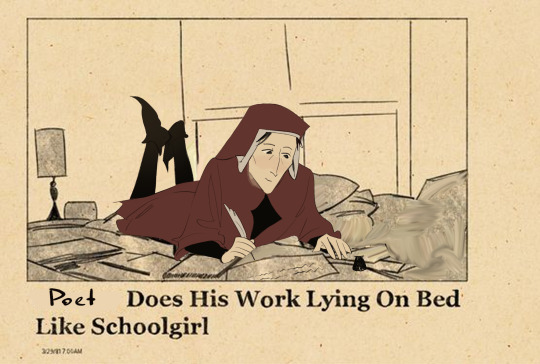
#dante alighieri#divine comedy#vergil#virgil#the divine comedy#dante#la divina commedia#beatrice#beatrice portinari#divina commedia#italian literature#medieval poetry#medieval literature
826 notes
·
View notes
Text
this sucks so bad i need to (remembers suicide jokes only make my mental health worse) find the holy grail
5K notes
·
View notes
Text

New Medieval Books: Waltharius: The Latin Epic of Walther of Aquitaine
57 notes
·
View notes
Text

The king ran to embrace him;
more than a hundred times
he hugs and kisses him.
As soon as he got a chance
he gave him back all of his land;
he gave him more than I’m telling you.
“Bisclavret” by Marie de France, 12th C.
Prints available here!
#bisclavret#happy pride month to my favorite bisexual werewolf knight and his boyfriend the king#I knew I had to post this before June was over#marie de france#medieval#medieval poetry#artists on tumblr#art#illustration#gay#pride month#bisexual#knightcore#medieval literature#knight#fantasy art#medieval art#fantasy#fantasy illustration#blackletter#handlettering#inprnt#digital art#werewolf#arthuriana#text at the top is the first three lines in the caption but in the original medieval French#ok addendum aurophine was my favorite bisexual werewolf knight but since she’s not a knight anymore…#< tag that only three other people in the world understand#thefourofdiamondsart
1K notes
·
View notes
Text
starting a band called ‘courtly love’ we perform exclusively covers of hole (band) songs on medieval instruments dressed as knights and ladies from a preraphaelite painting. we’d be a hit at renfaires from year to year
#ivy.txt#every day i get an idea#courtney love#medieval#knights#hole band#eardrums#medieval literature#courtly love#history#puns
623 notes
·
View notes
Text








Hey, you! Yeah, you! Do you like stories about adventure and romance with explicitly queer characters and happy endings? Do you like when women have agency in their own stories, and are allowed to pursue their own desires? Are you interested in getting into Medieval literature, but don't know where to start? Well, do I have the poem for you! Read Yde and Olive, an Old French story from the 12th century (Link to the English translation here!) about a teenager who disguises herself as a man and runs away from home to become a knight, and through a series of cool fight scenes and fun romance finds herself married to the daughter of the King of Rome. Considering this is the 12th century, this leads to some problems.
#medieval literature#arthuriana#yde et olive isn't arthurian but I made a ragnelle meme so it feels relevant#yde et olive#yde and olive#personally I read Yde as genderfluid but following the lead of scholars I am using she/her pronouns here for sake of clarity
91 notes
·
View notes
Text
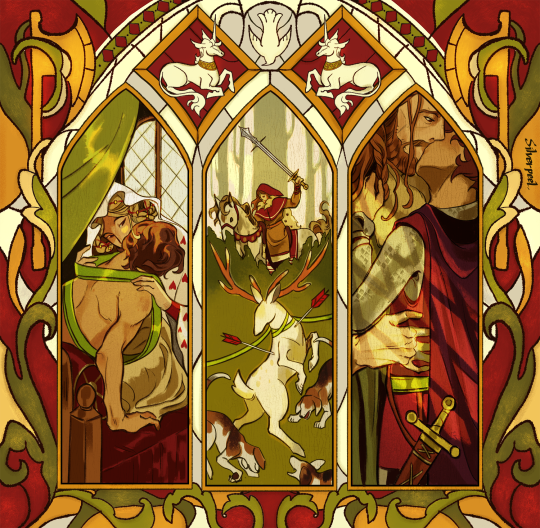
Celebrating new year and ending of the quest:)🕯️🎄🪓
product of my recent green knight reread on holidays, save me erotic hunting scene...... Happy new year, hope everyone have a nice starting of the year!
for hardcore fans yes lady bertilak dress lowkey reference form manuscript (feat. burrito gawain)
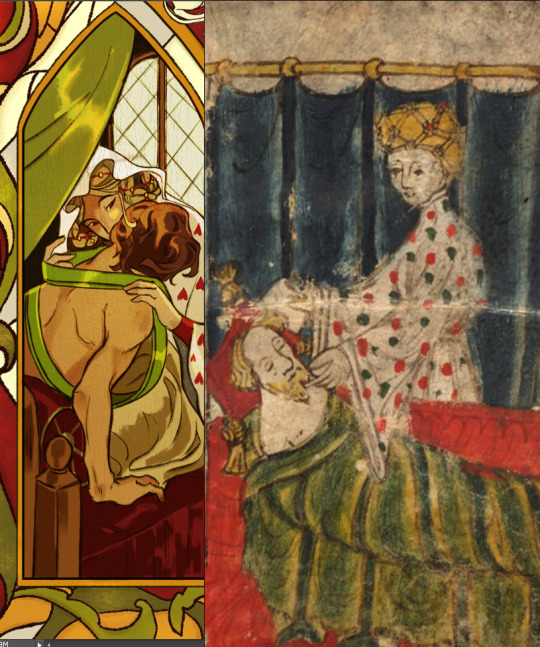
#arthuriana#medieval literature#sir gawain and the green knight#arthurian legend#gawain#lady bertilak#lord bertilak#captive unicorn reference for hunting scene allegory etc etc#have a good time making those stained glass#artists on tumblr#happy new year#illustration#my art
2K notes
·
View notes
Text

In La Mort le Roi Artu (The Death of King Arthur, c. 1220), when Lancelot and Guinevere are caught in the act they are actually around fifty and their relationship has lasted for 20-30 years.
Wanted to do a few illustrations that try to capture that dimension because adaptations tend to have them very young.
(In the text, Guinevere is explicitely past fifty, Lancelot is a bit younger, and the chronology is not always coherent but Gawain is 76 and Arthur is 92)
#arthuriana#illustration#watercolor#Lancelot#Guinevere#La Mort le Roi Artu#King Arthur#arthurian#arthurian legend#arthurian literature#arthurian mythology#litterature#medieval#medieval literature
223 notes
·
View notes
Text




59 notes
·
View notes
Text

is this anything
50 notes
·
View notes
Text
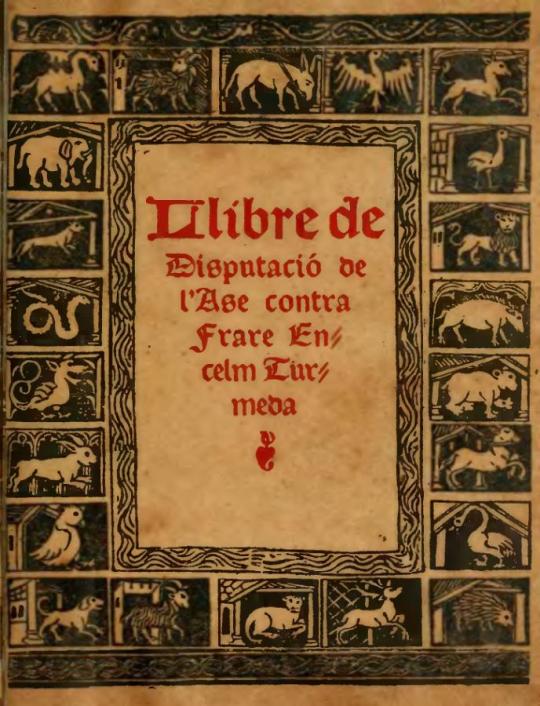
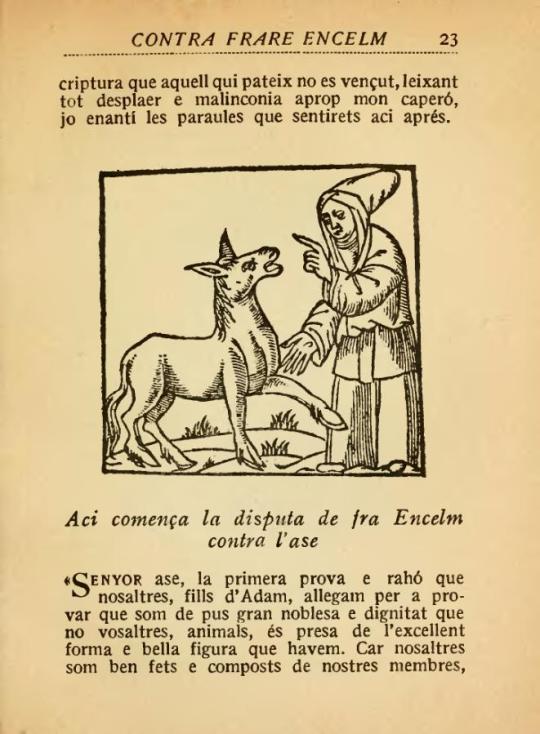
Cover and a page from the 1922 edition of The Donkey's Dispute.
Did you know that, in the year 1417, a writer wrote a novel where he almost looses an argument to a donkey?
This is The Donkey's Dispute (Disputa de l'Ase in Catalan) written by the Mallorcan author called Anselm Turmeda or Abd-Allah at-Tarjuman in his mother tongue Catalan.
The novella tells the story of an animal society where, after the death of their king the Lion, they appoint another lion as the next king. The celebrations for the crowning of the new king wake up Anselm Turmeda, who was sleeping nearby. The animals recognise him as the Mallorcan author who had defended the foolish idea that humans are superior to animals, and they decide to settle the topic with a public debate between Anselm and a representative chosen by the animals.
The animals choose "the filthy donkey with the tail cut off", a humble animal that Anselm dismisses as easy to beat but which proves to have a much higher intellect than expected. Anselm explains an argument for human superiority, but the donkey answers refuting it. Anselm presents 19 arguments, and the donkey makes 18 of them unusable thanks to his smart answers, which he also used to introduce witty and funny stories proving that many religious men are more than happy to take part in the seven deadly sins. The only argument for human superiority that the donkey can't refute is the last one: when God came to Earth, he took the shape of a human man, mixing his divinity with humans and becoming another "son of Adam", thus brother to humans. Jesus Christ did not make himself a donkey.
Even though the novella ends with a religious reference, it also includes moments that criticize the Catholic religious institution. For this reason, the Spanish Inquisition banned the book in 1583. As a result of the Inquisition's persecution, the manuscript and all the copies of the original version in Catalan have been lost, except for one part where the donkey makes a prophecy, which was printed separately.
Luckily, the book had been translated into other languages, and the Inquisition did not reach other countries to destroy the translated copies that were there. We know the full text of the book because a translation into French printed in Lyon in 1544 and a translation into German printed in Montbéliard in 1606 have been preserved.
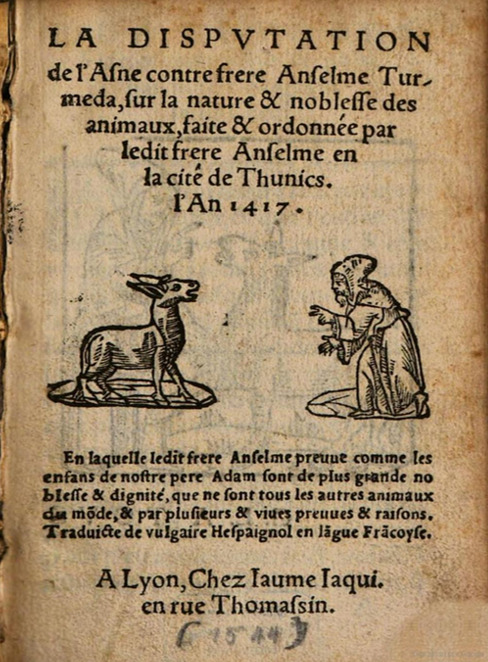
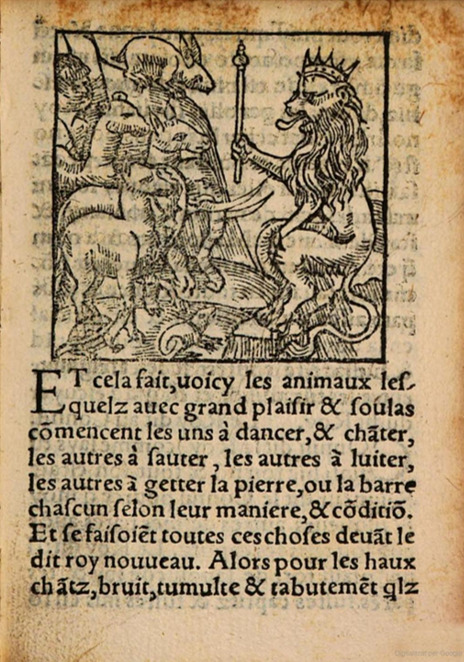
Cover and a page of the French translation from 1544. Google Books.
#literatura#arts#anselm turmeda#disputa de l'ase#la disputa de l'ase#disputa de l'ase contra el frare anselm turmeda#abdallah at-tarjuman#abd-allah at-tarjuman#inquisition#spanish inquisition#books#banned books#literature#medieval#medieval literature#medieval books#middle ages#1400s#1500s
77 notes
·
View notes
Text
i don't have the words to articulate it at this moment but there's something about the way that people have specific expectations for "authenticity" and will dismiss anything that falls outside them as a mangled, anglicised version of the thing when actually that is the older and more traditional form of something, it just doesn't match their expectations. obviously in my personal experiences i'm mostly talking about medieval literature here especially medieval irish literature
sometimes this is as simple as spelling – i've had people argue that the name "finn" is anglicised and it should always be "fionn" to be Really Irish, but "finn" is an older spelling, glide vowels are later, if you wanna go real far back it'll be "find" (nd in place of nn is an older spelling pattern). or they'll hear someone say "ogam" and assume they're mispronouncing "ogham" due to lack of knowledge of irish and not consider the fact that medievalists tend to use the older form of the word. or they'll Well Actually you about "correct" terminology which wasn't standardised (and/or invented) until the 20th century
a lot of this is defensive and the result of seeing a lot of people ACTUALLY get this stuff wrong and have no respect for the language. in that regard i understand it, although it becomes very tedious after a while, particularly when people sanctimoniously declare something "inauthentic", "fake", or "anglicised" without doing enough research to realise it's not trying to be modern irish and is in fact correct for older forms of the language
more often however this search for the projected "authenticity" is ideological and has much larger flaws and more problematic implications. "this can't be the real story because it's christian" well... that's the oldest version of the story that exists and it postdates christianity in ireland by about nine hundred years, so... maybe question why you're assuming the only "real" version of irish stories can't be a christian one? this is especially true when it comes to fíanaigecht material tbh, but in general there seems to a widespread misapprehension about ireland's historical relationship with christianity (i have seen people arguing that christianity in ireland is the result of english colonialism which took their "true" faith from them... bro. they were christian before the "english" existed. half the conversion efforts went the other way. please read some early medieval history thank you)
however i also saw someone saying this about arthurian literature lately which REALLY baffled me. "we'll never have the Real arthurian stories only the christianised versions" and it was in the context of chivalric romance. buddy you are mourning something that does not exist. this "authentic" story you're looking for isn't there. that twelfth century story you're dismissing as a christian bastardisation is as "real" a part of this tradition as you're going to get
#in general if you do not want christianity in your medieval literature maybe arthuriana is not the best choice#it is. so fucking christian#as for fíanaigecht. did they think st patrick was there by accident#the arthuriana comment took me out though.#the christianised versions. of chivalric romance.#YOU MEAN THE CHRÉTIENISED VERSIONS?? IS THAT THE PROBLEM?#anyway this is not a pro christianity statement this is a pro historical accuracy statement#medieval#medieval literature
2K notes
·
View notes
Text
i made something!

877 notes
·
View notes
Text
Hit Points & Chivalric Romance
So one of the bits of D&Discourse I find popping up perennially is the “hit points are unrealistic” thing. Or, at the least, that they shouldn’t represent actual wounds, but instead more of a fatigue/morale abstraction. Combat actually consists of each participant taking repeated sword blows to their body, while they shrug it off & keep fighting, only to then recover with simple rest or a healing potion? Nonsense. Ridiculous.
But if you read old chivalric romance — Chretien, Malory, the undiagnosed author who wrote Perlesvaus — that’s absolutely how knights carry on. Regularly you get descriptions of combat that involve Sir Protagonist and Sir Encounter d’Random fighting ankle-deep in their own blood for like an entire afternoon. Then they go rest in a hermitage until they’re better or — more often than you’d expect — are healed on the spot with Unspecified Ointment. Which is still ridiculous, but it’s ridiculous with a literary pedigree now.
The ointment is usually depicted as rarer than your D&D-style ten-for-a-platinum healing potion, but it’s there. The healing through rest isn’t as handwave-y: it’s usually weeks, not overnight, and the text generally does imply that the hermit or whoever is treating their wounds, not just letting them crash in a spare bed. (Though the fact that it’s often a hermit also gives credence to the “clerical healing” thing.) And there are instances of an injured knight later succumbing to his wounds despite the rest, so you know. It’s not quite as abstracted as D&D healing, but the bones are very familiar.
Which leads me to my proposal for a fantasy TTRPG mechanic: hit points are real, but only if you’re a knight. Along with the title & the fief & the obligation of fealty, you also get a new box on your character sheet that makes combat work differently for you now.
#d&d#dungeons and dragons#ttrpg#hit points#medieval#medieval literature#dnd#chretien#chretien de troyes#malory#thomas malory#perlesvaus#arthurian#arthuriana#ttrpg design
171 notes
·
View notes